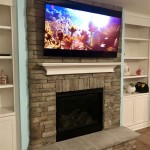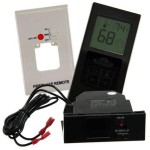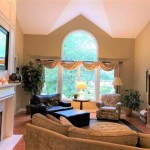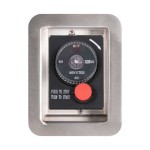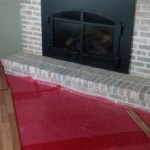Gas Wall Mounted Fireplaces: A Comprehensive Guide
Gas wall mounted fireplaces represent a modern and efficient heating solution for residential and commercial spaces. They offer a blend of aesthetic appeal, ease of use, and practical functionality, making them a popular choice for homeowners and designers alike. This article provides a comprehensive overview of gas wall mounted fireplaces, exploring their key features, benefits, installation considerations, and safety aspects.
Unlike traditional wood-burning fireplaces, gas wall mounted models do not require a chimney or extensive venting infrastructure in many cases. This characteristic simplifies installation and expands the possibilities for placement within a room. The absence of wood as fuel eliminates the need for storage and the associated mess, as well as the hassle of manually tending to a fire. Instead, these fireplaces operate on natural gas or propane, offering a readily available and controllable energy source.
The design versatility of gas wall mounted fireplaces is a significant advantage. They are available in a wide range of styles, from sleek and contemporary minimalist designs to more traditional and ornate options. This allows for seamless integration into various interior design schemes. Finishes can include stainless steel, black enamel, and other materials to complement the existing décor. Furthermore, the flame presentation can be customized, with options for realistic log sets, decorative glass beads, or modern ribbon flames.
Advantages of Gas Wall Mounted Fireplaces
Gas wall mounted fireplaces offer several distinct advantages over traditional fireplaces and other heating systems. These benefits contribute to their growing popularity and suitability for a variety of applications.
Ease of Use and Control: One of the primary advantages of gas wall mounted fireplaces is their ease of use. Most models feature electronic ignition systems, allowing for instant start-up with the push of a button or the flip of a switch. The flame height and heat output can be easily adjusted using a remote control or integrated control panel. This precise control allows users to customize the warmth and ambiance of the room according to their preferences.
Many gas wall mounted fireplaces also offer programmable thermostats and timers, further enhancing their convenience. Users can schedule the fireplace to turn on and off at specific times, maintaining a consistent room temperature and optimizing energy consumption. Some advanced models can even be controlled remotely via a smartphone app, providing unparalleled control and flexibility.
Compared to wood-burning fireplaces, gas models eliminate the need for manual ignition, stoking, and ash removal. This reduces the effort required to operate the fireplace and minimizes the potential for mess and inconvenience.
Efficiency and Cost-Effectiveness: Gas wall mounted fireplaces can be a cost-effective heating solution, particularly when used as a supplemental heat source. Many models are designed with high thermal efficiency ratings, meaning that they convert a significant portion of the fuel into usable heat. This reduces energy waste and lowers heating bills.
Direct-vent gas fireplaces, which draw combustion air from outside the house and vent exhaust gases directly outdoors, are particularly efficient. This sealed combustion system prevents the loss of heated air from the room and ensures optimal performance. Vent-free models, while also available, require careful consideration of ventilation requirements to ensure safe operation.
The cost-effectiveness of a gas wall mounted fireplace depends on several factors, including the price of natural gas or propane, the frequency of use, and the efficiency of the specific model. However, in many cases, gas fireplaces can provide a more economical heating solution than electric space heaters or central heating systems.
Cleanliness and Environmental Impact: Gas wall mounted fireplaces offer a cleaner and more environmentally friendly alternative to wood-burning fireplaces. They produce significantly fewer emissions, including particulate matter, carbon monoxide, and other pollutants. This reduces the impact on air quality and contributes to a healthier indoor environment.
The combustion of natural gas or propane is relatively clean, producing primarily carbon dioxide and water vapor. While carbon dioxide is a greenhouse gas, the emissions from gas fireplaces are typically lower than those from wood-burning fireplaces. Furthermore, the use of gas eliminates the need to cut down trees for firewood, reducing deforestation and promoting sustainable forestry practices.
The cleanliness of gas fireplaces also translates to easier maintenance. There is no ash to remove, no chimney to sweep, and no creosote buildup to worry about. This reduces the maintenance burden and prolongs the lifespan of the fireplace.
Installation Considerations
The installation of a gas wall mounted fireplace requires careful planning and attention to detail. It is essential to follow manufacturer's instructions and local building codes to ensure safe and proper operation. In many jurisdictions, installation must be performed by a qualified and licensed gas technician.
Venting Requirements: One of the most critical considerations is the venting system. Gas fireplaces are typically categorized as either direct-vent or vent-free. Direct-vent fireplaces require a venting system that runs directly to the outside of the house. This system draws combustion air from outside and vents exhaust gases outdoors, creating a sealed combustion chamber. Direct-vent systems are generally considered the safest and most efficient option.
Vent-free fireplaces, also known as ventless fireplaces, do not require a venting system. They draw combustion air from the room and release exhaust gases back into the room. Vent-free fireplaces are subject to strict regulations and safety standards due to the potential for carbon monoxide buildup. It is crucial to ensure adequate ventilation in the room where a vent-free fireplace is installed.
The choice between direct-vent and vent-free depends on several factors, including the location of the fireplace, the availability of venting options, and local building codes. Direct-vent fireplaces are generally preferred for their safety and efficiency, but vent-free models may be suitable in certain situations.
Gas Line Connection: Connecting the fireplace to a gas line requires careful planning and execution. A licensed gas technician should perform this task to ensure that the connection is safe and leak-free. The gas line must be properly sized to provide adequate gas flow to the fireplace. The technician will also need to install a shut-off valve for safety and maintenance purposes.
If the fireplace is being installed in a new location, a new gas line may need to be run from the main gas supply. This can involve trenching, pipe fitting, and other specialized tasks. It is essential to obtain the necessary permits and inspections before beginning any gas line work.
Electrical Considerations: Many gas wall mounted fireplaces require an electrical connection for the ignition system, control panel, and other features. The electrical wiring must be properly installed and grounded to ensure safe operation. A dedicated circuit may be required to prevent overloading the electrical system.
The installation of electrical wiring should be performed by a qualified electrician. The electrician will ensure that the wiring meets all applicable codes and standards. A ground fault circuit interrupter (GFCI) outlet may be required to protect against electrical shock.
Safety Features and Precautions
Gas wall mounted fireplaces are designed with numerous safety features to prevent accidents and ensure safe operation. However, it is essential to understand these features and follow all safety precautions to minimize the risk of fire, carbon monoxide poisoning, and other hazards.
Carbon Monoxide Detectors: Carbon monoxide (CO) is a colorless and odorless gas that can be produced by incomplete combustion of natural gas or propane. CO poisoning can be deadly, so it is essential to install carbon monoxide detectors in the vicinity of the fireplace. The detectors should be tested regularly to ensure that they are functioning properly.
If a carbon monoxide detector alarms, it is important to evacuate the premises immediately and call the fire department or gas company. Do not re-enter the building until the source of the CO has been identified and corrected.
Flame Supervision Devices: Most gas wall mounted fireplaces are equipped with flame supervision devices, such as thermocouples or flame sensors. These devices monitor the presence of a pilot light or flame. If the flame is extinguished for any reason, the device will automatically shut off the gas supply, preventing the buildup of unburned gas.
It is important to ensure that the flame supervision device is functioning properly. If the pilot light frequently goes out or the fireplace does not ignite consistently, the device may need to be inspected or replaced.
Overheat Protection: Some gas wall mounted fireplaces have overheat protection features that shut off the fireplace if it becomes too hot. This helps to prevent damage to the fireplace and surrounding materials. The overheat protection device may be a thermostat or a thermal fuse.
Clearances and Combustible Materials: It is essential to maintain adequate clearances between the fireplace and combustible materials, such as curtains, furniture, and wall coverings. The manufacturer's instructions will specify the minimum clearances required. Failure to maintain these clearances can increase the risk of fire.
Avoid placing any flammable materials directly in front of or on top of the fireplace. Keep the area around the fireplace clear of clutter and debris. Supervise children and pets when the fireplace is in operation.
By understanding the features, benefits, installation considerations, and safety aspects of gas wall mounted fireplaces, homeowners and designers can make informed decisions and ensure a safe and enjoyable experience.

Fire Ribbon Direct Vent Slim Gas Fireplace Spark Modern Fires

Fire Ribbon Direct Vent Slim Gas Fireplace Spark Modern Fires

Napoleon Whd48 Plazmafire Wall Hanging Fireplace

Loft Wall Mounted Gas Stoves Gazco

Plazmafire Vf24 Whvf24 Ambassador Fireplaces

Napoleon Gas Direct Vent Wall Mount Fireplace Whd31 Fireplaces Hvacdirect Com

Vent Free Archives SÓlas Contemporary Fireplaces

Gas Heating Stove Standalone 75 Ortal Usa Wall Mounted Contemporary Metal

Gas Fireplace X Fire 1200 Acquisitions Fireplaces Contemporary Closed Hearth Wall Mounted

Wall Mounted Gas Fireplace Black Frame Lava Fires
Related Posts


